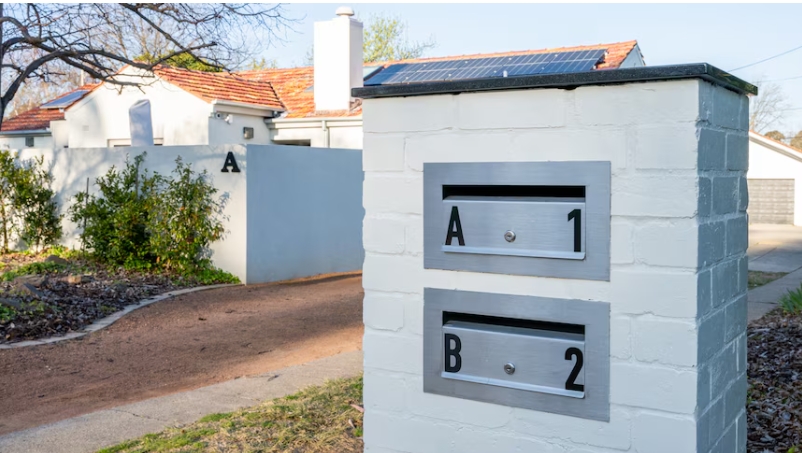Building a second dwelling on a residential Canberra block could soon be easier, under proposed changes to ACT planning rules that could see restrictions on block sizes removed.
With Canberra’s population expected to reach 784,000 by 2060, and the ACT Legislative Assembly passing a motion last month calling for a boundary to be set for the city’s urban growth, the territory government says there’s a need to address the “missing middle” in housing supply.
Missing middle housing refers to terraces, townhouses, duplexes and low-rise apartment buildings.
The government has today released a draft Missing Middle Housing Design Guide, which gives recommendations for developers and builders.
The changes would allow more medium-density housing to be developed in residential areas of Canberra. (ABC News: Greg Nelson)
It also proposed changes to the Territory Plan, which outlines what development can take place and where, including in residential zones 1 and 2 (RZ1 and RZ2).
RZ1, or “suburban zone”, blocks are the most common in Canberra — making up around 70 per cent of all blocks.
RZ2, or “suburban core”, blocks are generally found closer to suburban shops, services and arterial roads.
Key changes proposed for RZ1 and RZ2 include:
- Removing minimum area requirements for two homes on a single block
- Allowing unit titling on RZ1 blocks of more than 600 square metres, with no maximum size for additional dwellings
- Allowing subdivision on RZ1 blocks where a home has been lawfully built
- Permitting the consolidation of multiple blocks for developments where it will result in more homes
- Building height and site coverage limits
- An increase to tree canopy coverage requirements from 15 to 20 per cent.
Planning Minister Chris Steel says there will be adequate restrictions to ensure suburbs retain their character and aren’t overdeveloped by the changes. (ABC News: Callum Flinn)
ACT Planning Minister Chris Steel said the changes would enable more “missing middle” type housing to be built in both zones, while still respecting the character of suburbs and surrounding landscapes.
“Labor believes there’s a moral imperative to supply more housing for first home buyers, for growing families and for people that want to age in place,” Mr Steel said.
“But there’s not a lot of choice in the housing market at the moment. Townhouses, terraces, walk-up apartments, are effectively prohibited in most residential zones in Canberra.
“The government wants to make a change to allow those types of missing middle homes in residential suburbs in Canberra.”
Mr Steel said there would still be adequate restrictions to ensure suburbs retained their character and weren’t overdeveloped, with measures like the consolidation of blocks in RZ1 generally limited to 2,000 square metres where there’s no adjoining urban open space or a community path network.
Mr Steel says townhouses, terraces, and walk-up apartments are effectively prohibited in most Canberra residential zones under the current rules. (Supplied: ACT Suburban Land Agency)
He said the overall size of buildings would largely be controlled by site cover, setbacks, planting area and solar access requirements.
“We want to get the design right, which is why we’ve led with this Missing Middle Housing Design Guide, which will retain what we love about our streets, low-rise development and making sure that we’ve got tree canopy cover as well,” Mr Steel said.
“There’s also design guidance about how we can better utilise the adjacent green spaces to make sure that the development compliments the street, rather than taking away what we love.
“We’re only going to see a salt and pepper of this type of development happening in any one street over a period of time.
“Where this type of development has already been permitted, we see a couple of these pockets of missing middle housing development. It’s definitely not the whole street.”
Changes ‘could have gone further’
Greater Canberra convenor Howard Maclean says there’s a scarcity problem in Canberra’s affordable housing supply. (ABC News: Ian Cutmore)
Howard Maclean has firsthand experienced of the reality of a lack of affordable housing.
“When I was 23, I went to a share house inspection for rent in Turner, and the queue literally went around the block,” Mr Maclean said.
“There were about 50 or 60 people in that queue. I met so many people I knew — this is for a tiny, three-bedroom house.
“I was a student at the time at ANU, and that was a terrible situation. I actually ended up being homeless for about 10 days because we finally managed to get a place, but we didn’t get it in time.
“Scarcity is a problem. There is not enough housing supply in the places where people need and want to live.”
Mr Maclean is now the convenor of housing advocacy group Greater Canberra, which has been pushing for more “missing middle” type housing in established suburbs.
He welcomed the government’s proposal, but argued it could have gone further in removing restrictions for block consolidation.
“We think that those limits are a bit low, and potentially a bit arbitrary,” Mr Maclean said.
“If a developer can actually assemble 5,000 square metres a block, and is in a position to redevelop them all as one big and well designed townhouse or apartment complex, we think that the rules should allow that.”
Looking to other cities for examples of what has and hasn’t worked
Mr Maclean pointed to areas like Dickson as good examples of missing middle housing working and blending in with the more traditional, single-detached homes.
Mr Maclean says the government’s proposal could have gone further in removing restrictions for block consolidation. (ABC News: Ian Cutmore)
“These particular changes came about after the light rail rezoning along the light rail corridor,” he said.
“It’s a really good example of when we actually get these zoning reforms that legalises things like duplexes and terraces — it just happens, and people don’t particularly notice.
“And because we’re up zoning the entire city at once, the rate of change in every suburb will be quite low, which is, we think, a good thing.”
In 2016, the Auckland Council allowed a greater number of dwellings to be built on most suburban blocks across the city. (ABC News: Luke Bowden )
But the policy has also faced criticism where infrastructure like roads and public transport wasn’t upgraded to match the increase in population and density in some areas.
Mr Maclean said it was an important example of how systems like heritage preservation rules could conflict with the intent of planning law changes.
“The areas called Special Character Areas — SCA is in the Auckland terminology — we would call them heritage areas … all of those were in the centre of Auckland,” Mr Maclean said.
“As a result, all the development got pushed out.”
Mr Maclean said heritage rules in some of Canberra’s inner suburbs would make it “practically impossible” to redevelop some blocks.
“How much money are we paying to preserve Reid as purely a suburb of cottages when it’s the best located suburb for density and for housing in our city?” he said.
“How much housing are we willing to push out to West Belconnen to pay that price?”
Building industry welcomes changes
Master Builders ACT has been warning the territory is on track to fall short of its targets under the National Housing Accord.
Under the proposed changes, unit titling on RZ1 blocks of more than 600 square metres would be allowed, with no maximum size for additional dwellings. (ABC News: Matt Roberts)
While the organisation’s chief executive Anna Neelagama conceded issues that have impacted the sector nationally — like skilled workforce shortages — were a contributing factor, she said any change that would make it easier to build more homes was welcome.
“We think it will help drive activity in the sector at a time where it needs it the most,” Ms Neelagama said.
“But more importantly, it will deliver a greater variety of housing supply to Canberrans at any stage of life — whether you know you’re a retiree or whether you’re a new entrant to the housing market.
“But we need to get it right, and we need to make it as simple as possible to build these kinds of dwellings.”
Master Builders ACT CEO Anna Neelagama says there’s still work to do to when it comes to streamlining building approval processes. (ABC News: Ian Cutmore)
Ms Neelagama said there was still work to do to when it came to streamlining building approval processes .
“We’re seeing that builders can wait up to 30 months for [approval of] a dual-occupancy, and that is not good enough,”she said.
“We’re hopeful that, as this design guide becomes clear and the changes to the Territory Plan come into place, that we’re able to introduce new express-permitting.
“We have got to throw the kitchen sink at housing for Canberrans, so there’s affordable homes, so there’s many homes. “This is a good first step, but it’s a first step.”
Planning minister ‘expects support’ for changes
Mr Steel said the proposals would go before ACT Legislative Assembly committees, but he was hopeful the intent of the changes would receive broad support.
Mr Steel expects there will be support for the changes in the ACT Legislative Assembly. (ABC News: Nick Haggarty)
“Most parties in the legislative assembly provided support for more missing middle housing reform at the election,” Mr Steel said.
“So we expect that there will be support for this, but this is a very detailed piece of work.
“We’ve been working with architects, with the construction sector, to make sure that what we’re proposing is viable and can be built financially feasibly.
“Now we want to test what we’ve been able to produce with the broader community.”
Consultation on the government’s proposals is open until July 22, while long-form submissions will be accepted until August 5.



